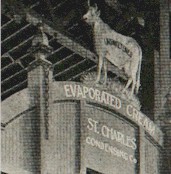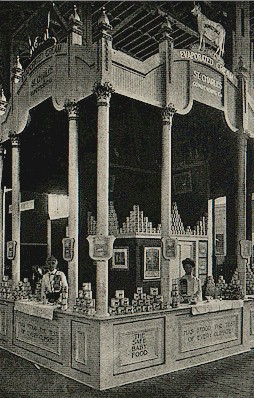
|
Agricultural History Series |
Missouri State University |
1904 St. Louis Worlds Fair
St. Charles Cream
In a corner booth at the Agriculture Palace stood a golden cow. This golden cow was the trademark of the St. Charles Cream. This cow is meant to bring peace and comfort unlike the golden calf of the bible which brought trouble and discord. The white-and-gold booth was decorated with pyramids of cream cans and many tiny statues of the golden cow.

St. Charles Cream Golden Cow
Cream would be served at the counter in little glasses and there would be puzzles given to the children for entertainment. While a person tasted the cream, one could admire the various awards and honors received by the St. Charles Cream.
The cream was recommended by nurses and doctors for children to drink. All that needed to be done to the cream was add water and it would become fluid milk. This was supposed to safer than ordinary milk out of the cow because the cream had been sterilized. Sterilization killed tuberculosis and many other diseases. The cream provided an alternative to ordinary milk for children who would get upset stomachs caused by the milk. The St. Charles Cream has been used for many years at the Chicago Foundlings’ Home and has had great results from it.

St. Charles Cream Exhibit
For cooking, the cream is said to preferable because it is pure unlike ordinary milk or cream. The cream was nice for custards, puddings, soups, ice cream, and confectionary. Obviously, the cream had an everyday use in tea, coffee, cocoa, and toppings for fruits. The cream was unsweetened and replaced fresh milk or cream for drinking and cooking. The cream was a convenience to many, because it was in a can be stored in the pantry and did not have to wait on the milk man to begin your cooking.
The St. Charles Cream was prepared from milk produced by selected cows, which were scientifically fed on outstanding farms. The farms were located from St. Charles, Illinois to Ingersoll, Ontario. The farms were under direct supervision from the company’s inspectors and much care would be taken at every step. The milk would be reduced to the consistency of cream by evaporation, and then it would be canned and preserved by a process of sterilization.
Reference: The World's Work Advertiser
This page was designed by Tobey Ellebracht and is maintained by Lyndon Irwin.